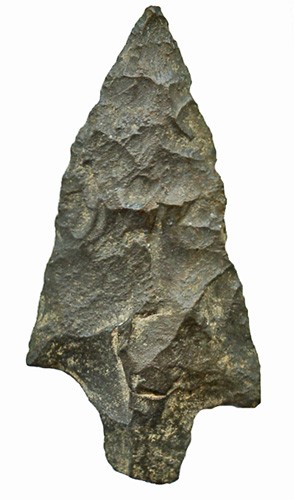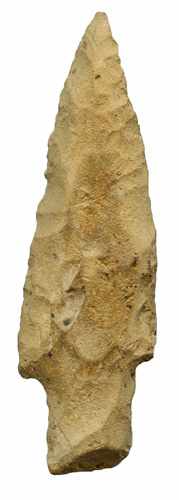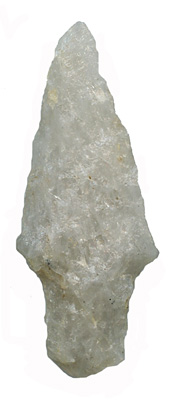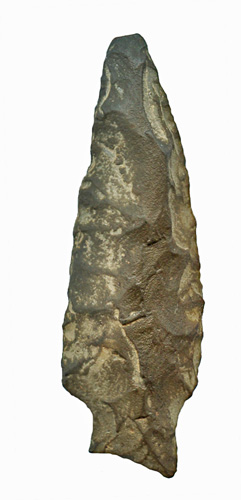







Point Type: LAMOKA a.k.a. Dustin, Durst Stemmed
Also See: Bradley Spike, Dewart Stemmed, Duncan's Island, Dustin,
Durst Stemmed, Garver's Ferry, Merrimack
, Neville, Piney Island, Randolph,
Sandhill, Sylvan Lake, Swan Lake, Wading River
Location: Northeastern States
Associated Dates: 5500 - 4500
B.P. -
Middle Archaic - Late Archaic
Morphology:
Side
Notched or Stemmed
General Description: The Lamoka point
is a medium to large sized, narrow, side notched point. There are
some varieties of the Lamoka that are not side notched but rather are
stemmed. The side notched forms may have C-shaped notches with a rounded
or straight base. Another side notched
form has asymmetric V- shaped notches that create an expanding stem with a straight or convex base.
These are small, narrow,
thick points with weak to moderately pronounced side notches. They
can be also straight stemmed with slightly slopingshoulders. The blade is basically trianguloid in outline, with biconvex or median ridged diamond shaped
cross section. The blade edges
are straight, excurvate or may have
one or both blade edges slightly incurvate.
The base is often
straight, but also oblique or slightly convex, and usually unworked and
just as thick as the blade. This thick, rather crude and unfinished
condition of the base is a prime diagnostic feature of the Lamoka point
wherever found. The Lamoka type is often crudely made by percussion flaking techniques only,
and sometimes a remnant of the cortex remains
on the stem base. Marginal retouching is rare.
There is a Dustin
subtype of the Lamoka that has a more bulbous basal
configuration.
The Lamoka point type is part of and a characteristic point type
in the Lamoka complex and is
a Middle to Late Archaic point. Both side notched and the stemmed versions
occur together in the same components and
at the same levels of strata but the
proportions vary somewhat from site to site.
The
size of the Lamoka
point ranges from 25 mm to 65 mm in length. The average size for the
point is in the 40 mm range.
The Lamoka type is typically made from
local materials principally cherts, quartz, and quartzite. A
pebble industry was indicated at the Lamoka Lake site.
The Lamoka
point type can be found in New York, all of southern New England into Vermont
and New Hampshire, Pennsylvania, New Jersey, Delaware, northern Virginia, West
Virginia, Ohio, Northern Indiana, Michigan, Wisconsin and northern
Illinois.
The Lamoka type was named by William A. Ritchie for the
Lamoka Lake site in New York.
Notes:
Ritchie
indicated that the Wading River type has some typological affinities with the
stemmed Lamoka point "especially in those specimens having a rough, "unfinished"
base, preserving traces of the rind of the pebble...".
Justice suggests
the Dustin and Durst Stemmed points are regional names for the Lamoka
points.
Boudreau notes that "to
understand the small stemmed or "narrow point" tradition is to understand that
small stemmed points are not a cultural manifestation. It seems more
likely they are a technological manifestation that transcended cultural
boundaries across much of eastern North America."
My personal note... it
appears to me that the Lamoka is a very difficult type to classify. It has
two separate stem shapes, and it is a very convenient type to attribute to an artifact. In
addition, here in Connecticut, there are very numerous Lamoka specimens which are made
from quartz. The quartz lithic material is quite difficult
to knap and this material results in some very crude
workmanship.
About the Point Above Left (shown twice size):
The average sized Lamoka point stemmed form pictured at the
top left hand side of this page, was found along the Susquehanna River near the
town of Berwick, Luzerne Co. Pennsylvania and is made from a weathered
Helderberg black chert. It is 41 mm in length, 21 mm wide at the
shoulders and 7.1 mm at its thickest point, which is in mid blade.
The stem is not ground and is not
thinned and has an asymmetrical base which retains rind on the basal edge. The
stem measures 8.4 mm wide at the side notches and is 8 mm long. Close examination
of the blade surface shows smoothing of the knapping scars (which retain
field dirt) due to some abrasion probably due to water erosion. The
material has a dull satin look and the workmanship is crude. This point was once in
the Herman Seltman collection. This point could be a Neville
Variant type but the rind on the basal edge swayed me
to keep it in the Lamoka category. Additionally, Seltman also concluded it
to be a Lamoka. Catalog Number
215-15-M
About the Point Above Center Left (shown twice
size): The large sized
Lamoka
point stemmed form pictured at the top left center of this page, was found in central New
York and is made from a weathered tan chert. It is 53 mm in
length, 16.1 mm wide at the shoulders and 7 mm at its thickest point,
which is in mid blade. The stem is not ground and is not thinned and
has an asymmetrical angled base which has retains the rind on the basal
edge. The stem measures 10.7 mm wide at the side notches and
is 12.8 mm long. Close examination of the blade surface shows
smoothing of the knapping scars (which retain field dirt) due to very heavy
abrasion probably due to erosion. The blade has a median ridge. The material has
a dull satin look and the workmanship is fairly good for the type.
Catalog Number
235-7-BB
About the Point
Above Center Right (shown twice size):
The average sized Lamoka point stemmed form pictured at the top right
center of this page, was found on the old Forbes Farm in East Hartford,
Connecticut and is made from white quartz. It is 44 mm in length, 17
mm wide at the shoulders and 9 mm at its thickest point, which is in mid
blade at the shoulders. The stem is not ground and is not thinned and
has a symmetrical angled base which does not retain the rind on
the basal edge. The stem measures 10.3 mm wide at the
side notches and is 15 mm long. Catalog Number 429-11-C
About the Point
Above Right (shown twice size):
The average sized Lamoka point stemmed form pictured
at the top right hand side of this page, was found
along the Susquehanna River near the town of Berwick, Luzerne Co. Pennsylvania
and is made from a weathered Helderberg black chert. It is 51 mm in
length, 16.5 mm wide at the shoulders and 7 mm at its thickest point,
which is in mid blade. The stem is not ground and is not thinned and
has an asymmetrical angled base. The stem measures 10.1 mm wide at the
side notches and is 9.8 mm long. Close examination of the
blade surface shows smoothing of the knapping scars (which retain field
dirt) due to very heavy abrasion probably due to water erosion. The blade
has a median ridge. The material has a dull satin look and the workmanship
is crude. This point was once in the Herman Seltman collection. Catalog Number 217-5-M
References: Boudreau, Fogelman, Hranicky (1), Justice (1), Overstreet, Ritchie, Snow
© Copyright 1997 - 2009 LITHICS-Net WWW.LITHICSNET.COM
Use your Browser's BACK Button to return to the LITHICS-Net Index.